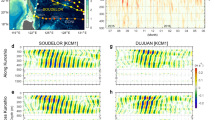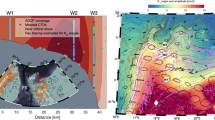Abstract
SOUTH of the latitude of the Cape of Good Hope, the Agulhas Current Stream (or at least most of it) turns back into the Indian Ocean and forms a zonal current called the Agulhas Return Current, whose mean axis of flow is approximately 38°–39°S. Near the start of its eastward flow, the Agulhas Return Current has been shown to undergo sharp changes of direction (Fig. 1a). These deflections are apparent in the analysis made by Dietrich1 and Le Pichon2. The latter shows them occurring down to the depth of the salinity maximum and draws attention to the important influence of bottom topography. They are also very evident in the study made by Darbyshire3 of data from the cruises of SAS Natal and RS Africana II, occurring in three out of the four seasons examined. The deflections all occur near a prominent topographical feature, the Agulhas Plateau, and their recurrence suggests that they are a quasi-stationary feature and possibly planetary waves caused by the rapid changes in water depth. An investigation into this possibility has been made by comparing the flow patterns deduced from hydrological data with those predicted by theory.
This is a preview of subscription content, access via your institution
Access options
Subscribe to this journal
Receive 51 print issues and online access
$199.00 per year
only $3.90 per issue
Buy this article
- Purchase on Springer Link
- Instant access to full article PDF
Prices may be subject to local taxes which are calculated during checkout
Similar content being viewed by others
References
Dietrich, G., Veroff. des. Inst. fur Meereskunde, 27, 1 (1935).
Le Pichon, X., J. Geophys. Res., 65, 12, 4061 (1960).
Darbyshire, J., Deep Sea Res., 11, 781 (1964).
Porter, G. H., and Rattray, jun., M., Deut. Hydr. Zeit., 17, 4, 164 (1964).
Simpson, E. S. W., and Forder, E., Chart 123A (third ed.) (University of Cape Town, 1969).
Shipley, A. M., and Zoutendyk, P., Univ. Cape Town, Data Report, 2 (1964).
Orren, M. J., Invest. Rep. Sea Fish. S. Afr., 45 (1963).
S.A. Division of Sea Fisheries, Manuscript data Africana II cruise, July 1962.
Woods Hole Oceanographic Institution, Anton Bruun, Cruise, 6 (1965).
Meteorological Office, Met. Office, 772 (HM Stationery Office, 1966).
Tchernia, P., Le Floch, J., Lacombe, H., Bull. d'Information du Comité Central d'Oceanographique et d' Études des Côtes, 3, 10 (1951).
Author information
Authors and Affiliations
Rights and permissions
About this article
Cite this article
HARRIS, T. Planetary-type Waves in the South West Indian Ocean. Nature 227, 1043–1044 (1970). https://doi.org/10.1038/2271043a0
Received:
Issue Date:
DOI: https://doi.org/10.1038/2271043a0
Comments
By submitting a comment you agree to abide by our Terms and Community Guidelines. If you find something abusive or that does not comply with our terms or guidelines please flag it as inappropriate.



